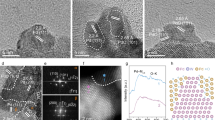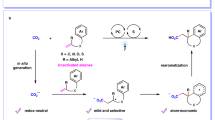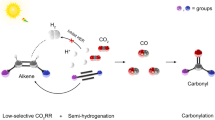Abstract
Although carbon dioxide (CO2) is highly abundant, its low reactivity has limited its use in chemical synthesis. In particular, methods for carbon–carbon bond formation generally rely on two-electron mechanisms for CO2 activation and require highly activated reaction partners. Alternatively, radical pathways accessed via photoredox catalysis could provide new reactivity under milder conditions. Here we demonstrate the direct coupling of CO2 and amines via the single-electron reduction of CO2 for the photoredox-catalysed continuous flow synthesis of α-amino acids. By leveraging the advantages of utilizing gases and photochemistry in flow, a commercially available organic photoredox catalyst effects the selective α-carboxylation of amines that bear various functional groups and heterocycles. The preliminary mechanistic studies support CO2 activation and carbon–carbon bond formation via single-electron pathways, and we expect that this strategy will inspire new perspectives on using this feedstock chemical in organic synthesis.
This is a preview of subscription content, access via your institution
Access options
Subscribe to this journal
Receive 12 print issues and online access
$259.00 per year
only $21.58 per issue
Buy this article
- Purchase on Springer Link
- Instant access to full article PDF
Prices may be subject to local taxes which are calculated during checkout



Similar content being viewed by others
References
Arakawa, H. et al. Catalysis research of relevance to carbon management: progress, challenges, and opportunities. Chem. Rev. 101, 953–996 (2001).
Appel, A. M. et al. Frontiers, opportunities, and challenges in biochemical and chemical catalysis of CO2 fixation. Chem. Rev. 113, 6621–6658 (2013).
Liu, Q., Wu, L., Jackstell, R. & Beller, M. Using carbon dioxide as a building block in organic synthesis. Nat. Commun. 6, 5933 (2015).
Sakakura, T., Choi, J.-C. & Yasuda, H. Transformation of carbon dioxide. Chem. Rev. 107, 2365–2387 (2007).
Aresta, M. in Activation of Small Molecules: Organometallic and Bioinorganic Perspectives (ed. Tolman, W. B.) 1–41 (Wiley-VCH, 2006).
Omae, I. Recent developments in carbon dioxide utilization for the production of organic chemicals. Coord. Chem. Rev. 256, 1384–1405 (2012).
Wu, J. et al. Continuous flow synthesis of ketones from carbon dioxide and organolithium or Grignard reagents. Angew. Chem. Int. Ed. 53, 8416–8420 (2014).
Jones, J. Amino Acid and Peptide Synthesis (Oxford Univ. Press, 2002).
Otero, M. D., Batanero, B. & Barba, F. CO2 anion–radical in organic carboxylations. Tetrahedron Lett. 47, 2171–2173 (2006).
Morgenstern, D. A., Wittrig, R. E., Fanwick, P. E. & Kubiak, C. P. Photoreduction of carbon dioxide to its radical anion by nickel cluster [Ni3(μ3-I)2(dppm)3]: formation of two carbon–carbon bonds via addition of carbon dioxide radical anion to cyclohexene. J. Am. Chem. Soc. 115, 6470–6471 (1993).
Fagnoni, M., Dondi, D., Ravelli, D. & Albini, A. Photocatalysis for the formation of the C−C bond. Chem. Rev. 107, 2725–2756 (2007).
Prier, C. K., Rankic, D. A. & MacMillan, D. W. C. Visible light photoredox catalysis with transition metal complexes: applications in organic synthesis. Chem. Rev. 113, 5322–5363 (2013).
Nicewicz, D. A. & Nguyen, T. M. Recent applications of organic dyes as photoredox catalysts in organic synthesis. ACS Catal. 4, 355–360 (2014).
Schultz, D. M. & Yoon, T. P. Solar synthesis: prospects in visible light photocatalysis. Science 343, 1239176 (2014).
Beatty, J. W. & Stephenson, C. R. J. Amine functionalization via oxidative photoredox catalysis: methodology development and complex molecule synthesis. Acc. Chem. Res. 48, 1474–1484 (2015).
Zuo, Z. et al. Merging photoredox with nickel catalysis: coupling of α-carboxyl sp3-carbons with aryl halides. Science 345, 437–440 (2014).
Lamy, E., Nadjo, L. & Saveant, J. M. Standard potential and kinetic parameters of the electrochemical reduction of carbon dioxide in dimethylformamide. J. Electroanal. Chem. Interfacial Electrochem. 78, 403–407 (1977).
Fujita, E. & Brunschwig, B. S. in Electron Transfer in Chemistry (ed. Balzani, V.) 88–126 (Wiley-VCH, 2001).
Matsuoka, S. et al. Photocatalysis of oligo(p-phenylenes): photochemical reduction of carbon dioxide with triethylamine. J. Phys. Chem. 96, 4437–4442 (1992).
McQuade, D. T. & Seeberger, P. H. Applying flow chemistry: methods, materials, and multistep synthesis. J. Org. Chem. 78, 6384–6389 (2013).
Ley, S. V., Fitzpatrick, D. E., Myers, R. M., Battilocchio, C. & Ingham, R. J. Machine-assisted organic synthesis. Angew. Chem. Int. Ed. 54, 10122–10136 (2015).
Mallia, C. J. & Baxendale, I. R. The use of gases in flow synthesis. Org. Process Res. Dev. 20, 327–360 (2016).
Cambié, D., Bottecchia, C., Straathof, N. J. W., Hessel, V. & Noël, T. Applications of continuous-flow photochemistry in organic synthesis, material science, and water treatment. Chem. Rev. 116, 10276–10341 (2016).
McNally, A., Prier, C. K. & MacMillan, D. W. C. Discovery of an α-amino C–H arylation reaction using the strategy of accelerated serendipity. Science 334, 1114–1117 (2011).
Chowdhury, F. A., Yamada, H., Higashii, T., Goto, K. & Onoda, M. CO2 capture by tertiary amine absorbents: a performance comparison study. Ind. Eng. Chem. Res. 52, 8323–8331 (2013).
Telmesani, R., Park, S. H., Lynch-Colameta, T. & Beeler, A. B. [2+2] photocycloaddition of cinnamates in flow and development of a thiourea catalyst. Angew. Chem. Int. Ed. 54, 11521–11525 (2015).
Singh, S. B. Total synthesis of flutimide, a novel endonuclease inhibitor of influenza virus. Tetrahedron Lett. 36, 2009–2012 (1995).
Aschwanden, P., Stephenson, C. R. J. & Carreira, E. M. Highly enantioselective access to primary propargylamines: 4-piperidinone as a convenient protecting group. Org. Lett. 8, 2437–2440 (2006).
Clark, J. C., Phillipps, G. H., Steer, M. R., Stephenson, L. & Cooksey, A. R. Resolution of esters of phenylglycine with (+)-tartaric acid. J. Chem. Soc. Perkin Trans. 1, 471–474 (1976).
Wegman, M. A. et al. Dynamic kinetic resolution of phenylglycine esters via lipase-catalysed ammonolysis. Tetrahedron: Asymmetry 10, 1739–1750 (1999).
Acknowledgements
We thank the Novartis-MIT Center for Continuous Manufacturing for financial support and several Novartis colleagues for suggestions, in particular B. Schenkel, B. Martin, J. Sedelmeier, G. Penn, F. Venturoni and J. Haber. H.S. is grateful for a graduate fellowship from the Korean Government Scholarship Program for Study Overseas, and M.H.K. was supported by a postdoctoral fellowship from the National Institute of General Medical Sciences (F32GM108181). The content of this paper is solely the responsibility of the authors and does not necessarily represent the official views of the National Institutes of Health. We thank A. B. Beeler for guidance in setting up the flow photochemistry system, T. M. Swager for the use of a spectrophotometer and L. Li for mass spectral data (conducted on an instrument purchased with the assistance of National Science Foundation Grant CHE-0234877).
Author information
Authors and Affiliations
Contributions
H.S. and M.H.K. performed the experiments, M.H.K. and T.F.J. conceived the idea and H.S., M.H.K. and T.F.J. designed the research and wrote the manuscript: All the authors commented on the final draft of the manuscript and contributed to the analysis and interpretation of the data.
Corresponding author
Ethics declarations
Competing interests
T.F.J. is a cofounder of Snapdragon Chemistry, Inc., and a scientific adviser for Zaiput Flow Technologies, Continuus Pharmaceuticals, Paraza Pharmaceuticals and Asymchem.
Supplementary information
Supplementary information
Supplementary information (PDF 6555 kb)
Rights and permissions
About this article
Cite this article
Seo, H., Katcher, M. & Jamison, T. Photoredox activation of carbon dioxide for amino acid synthesis in continuous flow. Nature Chem 9, 453–456 (2017). https://doi.org/10.1038/nchem.2690
Received:
Accepted:
Published:
Issue Date:
DOI: https://doi.org/10.1038/nchem.2690
This article is cited by
-
Visible-light-driven synthesis of N-heteroaromatic carboxylic acids by thiolate-catalysed carboxylation of C(sp²)–H bonds using CO2
Nature Synthesis (2024)
-
Arylcarboxylation of unactivated alkenes with CO2 via visible-light photoredox catalysis
Nature Communications (2023)
-
Metal-free reduction of CO2 to formate using a photochemical organohydride-catalyst recycling strategy
Nature Chemistry (2023)
-
Minireview: recent efforts toward upgrading lignin-derived phenols in continuous flow
Journal of Flow Chemistry (2023)
-
Energy- and atom-efficient chemical synthesis with endergonic photocatalysis
Nature Reviews Chemistry (2022)



